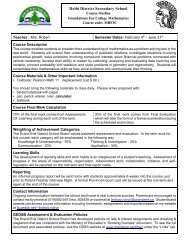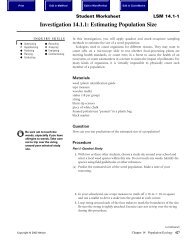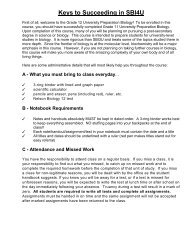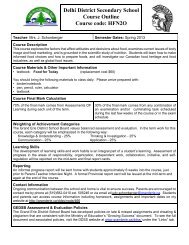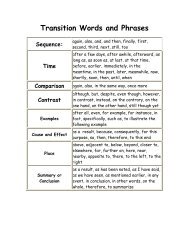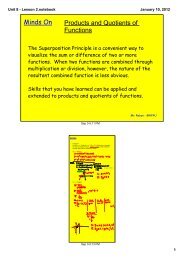Chapter 4.pdf
Chapter 4.pdf
Chapter 4.pdf
Create successful ePaper yourself
Turn your PDF publications into a flip-book with our unique Google optimized e-Paper software.
DI<br />
Key Activity<br />
B3<br />
Inquiry Activity<br />
Identifying Gases<br />
Changes to matter can result in the formation of<br />
gases. There are many different kinds of gas, and we<br />
can use their properties to help identify them. Three<br />
common gases are hydrogen, oxygen, and carbon<br />
dioxide.<br />
• Oxygen gas will cause a glowing splint to<br />
reignite (catch fire).<br />
• Carbon dioxide gas will put out a flame.<br />
• Hydrogen gas will make a “pop” sound in the<br />
presence of a flaming splint.<br />
Materials & Equipment<br />
• 3 medicine droppers<br />
• 3 medium test tubes<br />
• test-tube rack<br />
• 3% hydrogen peroxide solution<br />
• dish soap<br />
• scoopula<br />
• potassium iodide powder<br />
• matches<br />
• wooden splints<br />
• 0.1 M acetic acid solution<br />
• sodium hydrogen carbonate powder<br />
• 2 M hydrochloric acid solution<br />
• forceps<br />
• mossy zinc chunks<br />
• 1 large test tube<br />
• test-tube holder<br />
CAUTION: Hydrogen peroxide may sting your skin.<br />
Potassium iodide will stain skin and clothing. Keep your<br />
hair tied back when working near open flames.<br />
Skills Reference 1<br />
Purpose<br />
To use gas tests to identify oxygen gas, carbon dioxide<br />
gas, and hydrogen gas<br />
Procedure<br />
Part 1 — Preparation of Oxygen<br />
1. Using a medicine dropper, add 1 mL (about<br />
20 drops) of hydrogen peroxide solution to a<br />
clean test tube.<br />
2. Add two drops of dish soap.<br />
3. Using a scoopula, add a small amount (less than<br />
the size of a pea) of potassium iodide powder to<br />
the test tube.<br />
4. Use matches to light a wooden splint.<br />
5. Blow out the flame to make a glowing splint. Insert<br />
the glowing splint into the mouth of the test tube.<br />
Observe and record what happens to the splint.<br />
6. Clean up as directed by your teacher.<br />
SKILLS YOU WILL USE<br />
Conducting inquiries safely<br />
Processing and synthesizing<br />
data<br />
Figure 4.13 A glowing splint will reignite in the presence<br />
of oxygen.<br />
Part 2 — Preparation of Carbon Dioxide<br />
7. Using a medicine dropper, add 1 mL (about<br />
20 drops) of acetic acid to the second clean test<br />
tube.<br />
144 UNIT B Atoms, Elements, and Compounds



